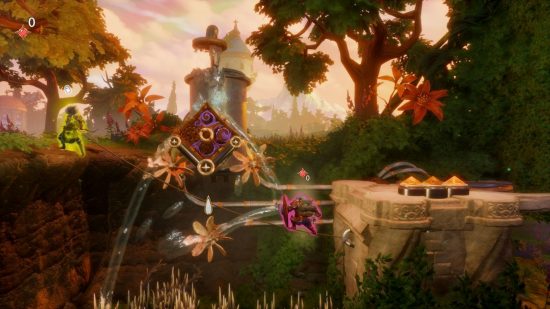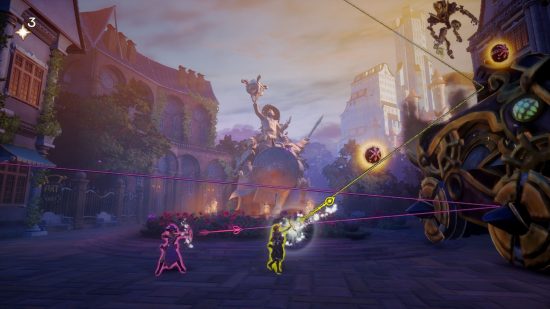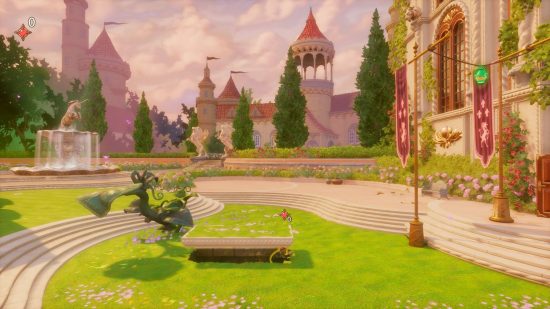Trine 5 Switch review -It’s still magic even if you know how it’s done

I’m a big fan of the Trine series. While it’s had its weak points (we don’t talk about Trine 3) it has always held a special place in both my heart and the hearts of many others. With the first two games truly creating a magical legacy and Trine 4’s endeavors to bring the series back on track, the Trine 5: A Clockwork Conspiracy trailer looked extremely promising – but can it hold a candle to the beloved Trine 2? Well, I suppose that’s why you’re reading my Trine 5 review, right?
Trine 5 once again casts aside the awkward sidescrolling 3D mishmash of 3, sticking to beautifully rendered 2.5D models in a side-scrolling world. Our much-loved motley crew is back, too, with Amadeus, Pontius, and Zoya each getting their time to shine.
The plot revolves around those three heroes of Trine uniting again, as they receive an invite to a ceremony where they are to be awarded a medal for their bravery – as Zoya says, apparently a massive statue of her and her fellows isn’t enough. However, things are not quite as they seem, and it quickly becomes apparent that the battle isn’t over, and they’re not getting that medal after all.
Its narrative, characters, and world are, as always, wonderfully fantasy-fueled and full of magic. From the enchanting color schemes of the backdrop to Amadeus’ – well, Amadeus in general, the entire thing feels like a Terry Pratchett novel, and I adore it.

Trine 5 once again allows you to switch between the three heroes on the fly, and supports drop in, drop out co-op for up to four people. You can choose whether to set the multiplayer to allow only one of each character, or to let as many people play the same character as you like.
I personally prefer the latter option, as it allows for more room to navigate with multiple players. For example, if there’s a hook that you need to use to get across a cavern, being able to have all players change to Zoya to swing over makes it much less convoluted, though I do understand the appeal of the classic mode.
The core gameplay revolves around puzzles that require thoughtful use of the different characters’ abilities. As you slowly gain access to a wider range of skills for each character, the puzzles become a bit more complicated, as there’s a lot to remember. A prime example of this is when my partner and I spent a good ten minutes desperately trying to glitch up through a hole in the ceiling, until I had an epiphany and remembered Pontius’ throwing sword ability that we’d learned the day before, allowing me to create a platform for us to swing on as Zoya.
The puzzles are rarely too difficult, but they are quite thoughtful and make great use of the different abilities you accrue. I also love the fact that there are multiple ways to solve most of the puzzles. In fact, we often find ourselves completing sections of the game in what’s likely the most difficult way possible, and only realizing what the devs likely intended us to do after pushing through. Plenty of hilarity also comes with this, along with you and your pals accidentally dooming each other to fall off a cliff several times per level.
There are, however, several unlockable abilities that truly make certain areas a breeze. My personal favorite is Amadeus’ wind storm. If you unlock the second tier of that ability, it grows from a simple AoE combat move to a mobility move, which allows you to jump in the air, hit the X button, then jump again. This can get you past some seriously high platforms with some practice, which kinda feels like cheating – but it’s also a great option to save yourself from a serious fall (or some serious time, if you like).
These unlockable skills also enhance your core kit. For example, Amadeus can summon spheres as well as cubes and platforms, Zoya can bounce her arrows off walls, Pontius can slide on his shield, and plenty more. You unlock most of these through a skill tree using the green, glowing collectables you gather at checkpoints along the way, while others come through scripted sequences where you take control of one character and progress through a mini level, at the end of which you unlock a chest with an upgrade.
As with previous games in the series, combat is not Trine 5’s strongest point. As you may guess from the name of the game, your main enemies here are large, conspiring clockwork automatons that come in a variety of flavors. Some wield shields, some have giant axes or throwable bombs, and others are flying drone-type thingamajigs that shoot you from above.
Even with Pontius’ shield and Zoya’s range, you often find yourself vulnerable from at least one side, and it’s very easy to get muddled in the heat of battle, accidentally creating a platform as Amadeus instead of launching a barrage of arrows as Zoya.
As you unlock more of those aforementioned talents, you certainly gain more handy abilities to use in combat, such as sticky bombs, explosive boxes, and a big ol’ hammer. But even then, combat feels a bit clunky and mucky, especially with multiple players and enemies taking up the already busy screen.
However, I do feel that it’s possible to master the combat if you really get into the swing of it, and the enemy and boss designs are great. Luckily, even if the combat isn’t your jam, the battles are often short and not too frequent as they really aren’t the focus of the game, and I’m glad of that – the puzzles are where Trine truly shines.
Trine 5 is split into five acts, each broken down into several levels. The levels all have their own unique theme and vibe while still maintaining cohesion with both the rest of the game and the series as a whole. It’s longer than previous games in the series, with plenty of unique challenges that mean two playthroughs can offer some variety if you approach them in different ways or with a different amount of players.
Performance-wise, the game looks and runs beautifully on my Switch OLED in both handheld and docked mode. The colors are vibrant, the framerates look smooth, and I’ve experienced no stuttering or lag. There have been occasional glitches, such as Zoya hooking onto something on the other side of a grate and levitating, or one of Amadeus’ conjured objects shimmying all over the place, but these are more entertaining than game breaking.
However, I do have to mention one glitch where we went into an underground cavern, and somehow the moving platform that was supposed to take us back up to the surface got stuck above ground (as seen in the picture above), so we ended up having to jump off a ledge a few times to spawn back above ground. Luckily, even if your character(s) die, the game saves the collectables you’ve gathered, so there’s very little to lose.
Overall, Trine 5 does a brilliant job of living up to its much-loved predecessors, and it’s brilliant to see the series back on track. It offers plenty more of that enchanting Trine personality, along with a lot of intriguing puzzles and mechanics to explore. It’s a wonderful couch co-op option and still stands up as a strong single player game. If you enjoyed Trine 1, 2, and 4, then this is sure to satisfy you.
Right, before you conjure up a floating platform or hop on a giant pink hedgehog, be sure to check out our top picks for the best Switch RPGs, the best Switch platformers, the best Switch puzzle games, or the best Switch games overall. Oh, and watch out for those automatons – they aren’t to be trusted.
Trine 5 Switch review
Trine 5 is an utterly enchanting and charming game, that truly conjures up the same magic as its much loved predecessors. With a fantastical narrative, the return of lovable characters, and more puzzles than you can shake a wand at, it’s a brilliant couch co-op experience to enjoy alone or with friends.






